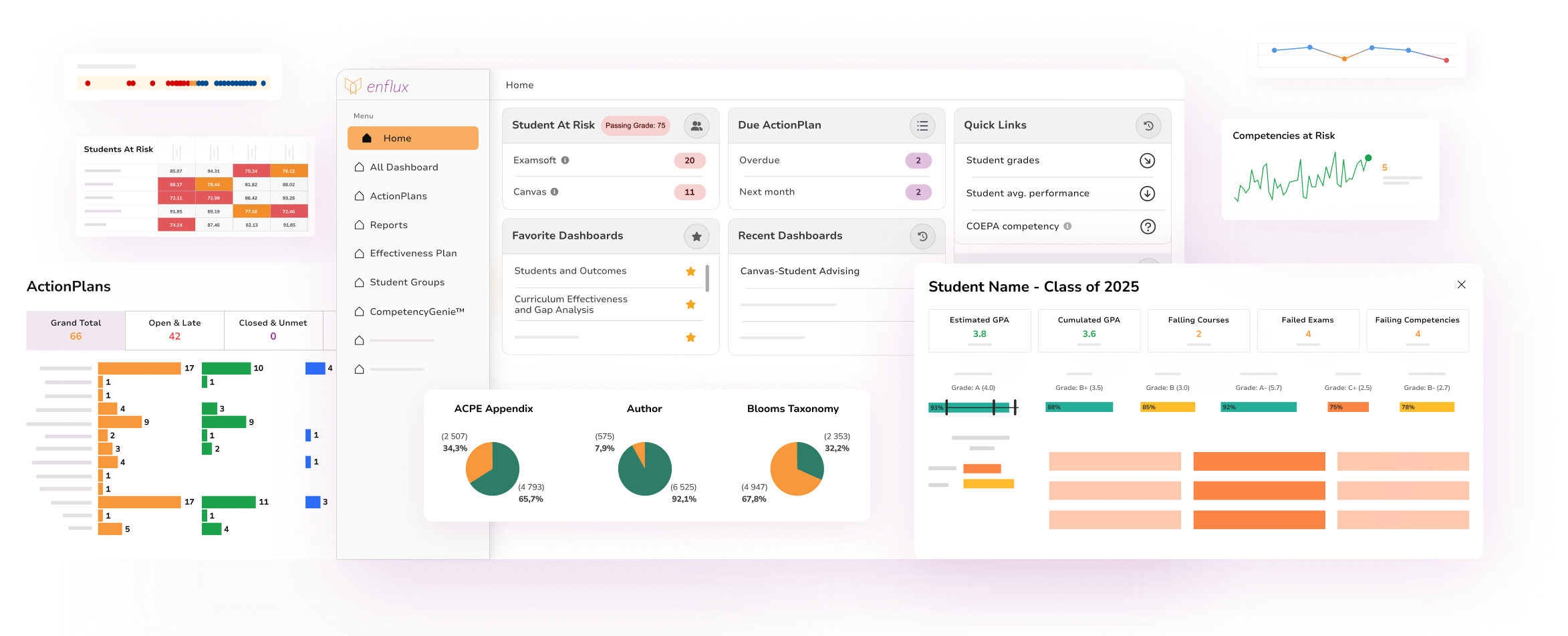
Competency-Based Learning in Nursing: Curriculum Mapping, Outcomes, and NCLEX Success
Healthcare today operates in an environment defined by rapid innovation, rising patient complexity, and growing demands for safe, high‑quality, and equitable care. These realities require nurses who are not only knowledgeable but demonstrably competent in clinical reasoning, communication, and leadership.
Competency-based learning in nursing education offers a forward‑thinking approach to meeting these challenges. By integrating competency-based curriculum design, data-driven decision-making, and curriculum mapping, nursing programs can align with accreditation standards, strengthen student learning outcomes, and improve NCLEX passing rates.
Why competency-based curriculum design matter
As healthcare evolves, nursing education must bridge the persistent gap between classroom preparation and clinical readiness. This gap often shows up in NCLEX performance: according to the National Council of State Boards of Nursing (NCSBN), first-time U.S. test-takers in 2025 achieved an 88.8% NCLEX-RN pass rate, while repeat candidates passed at 49.3%. These figures highlight the need for curriculum models that ensure students master essential competencies before graduation.
Competency-based curriculum development helps close this gap. Unlike traditional models that emphasize credit hours or clinical time, competency-based education (CBE) focuses on demonstrated mastery of essential nursing knowledge, skills, and behaviors—ensuring students are ready to provide safe, entry-level care on day one.
Competency-based learning as a foundation for measurable outcomes
Competency-based education represents a paradigm shift in nursing education. Instead of advancing students based on time, it uses outcome-based progression, where learners move forward only after demonstrating competence.
The AACN 2021 Essentials define competency‑based education as ‘a system of instruction, assessment, feedback, self‑reflection, and academic reporting that is based on students demonstrating that they have learned the knowledge, attitudes, motivations, self‑perceptions, and skills expected of them as they progress through their education.’
Core principles of competency-based curriculum design
CBE in nursing is grounded in several key principles that guide competency-based curriculum design and assessment:
- Backward curriculum design: Identify desired competencies first, then structure learning experiences and assessments to achieve them.
- Curriculum mapping: Align program outcomes, student learning outcomes (SLOs), and course objectives to nursing accreditation frameworks such as the AACN Essentials, the Commission on Collegiate Nursing Education (CCNE), and NLN standards.
- Observable, measurable outcomes: Learning is demonstrated through performance, not attendance or time.
- Formative assessment and feedback: Students receive continuous, focused feedback that supports reflective practice and improvement.
- Integration of theory and practice: Classroom knowledge is applied in simulations, clinical settings, and project-based learning.
By embedding these principles, competency-based learning fosters stronger clinical judgment, interprofessional collaboration, and communication skills, producing practice-ready graduates.
Moreover, when curricula are systematically aligned with accreditation standards and assessment data, programs strengthen their ability to demonstrate quality and achieve improved NCLEX passing rate outcomes.
Data-driven insights to strengthen competency-based learning in nursing education
Implementing competency-based education (CBE) in nursing is not simply a curriculum redesign—it’s a transformation of the entire educational ecosystem. Faculty must ensure that competencies outlined in the AACN Essentials are intentionally woven into every course, assessment, and learning experience. Yet this process often becomes overwhelming due to fragmented data systems, manual mapping, and limited visibility into how learning outcomes connect to student performance. Without efficient analytics, nursing programs risk losing the precision and transparency required for both accreditation and student success.
This is where a learning analytics platform like Enflux provides measurable value. By integrating data from LMS platforms, exam software, and course content into one analytics environment, Enflux gives faculty and deans a real-time view of curriculum alignment, competency progression, and student learning outcomes—all in support of program excellence.
Practical applications of learning analytics in competency-based nursing education
In nursing education, data is not just a metric—it’s a mirror of readiness. Faculty decisions affect patient outcomes indirectly, and those decisions should be guided by evidence rather than intuition. Enflux enables programs to:
- Demonstrate accreditation alignment with confidence. Enflux connects curriculum data to nursing accreditation frameworks such as the AACN 2021 Essentials, CCNE, and NLN standards. The result is clear, visual documentation of how every course, assessment, and activity supports required competencies. This streamlines reporting and reduces the faculty workload typically associated with accreditation reviews.
- Identify and support at-risk students early. Through predictive analytics, faculty can monitor performance trends across courses and competencies, intervening before academic struggles affect NCLEX readiness or progression. This proactive approach supports both student retention and overall program outcomes.
- Ensure transparency and accountability in teaching and assessment. With Enflux dashboards, nursing programs can track how competencies are taught, assessed, and achieved across semesters—creating a continuous feedback loop for program improvement.
- Strengthen evidence-based curriculum design. Enflux applies backward curriculum design principles, guiding faculty through a structured process of aligning outcomes, assessments, and instructional strategies. The platform helps ensure that each competency is measurable, mapped, and supported by appropriate learning activities.

Continuous improvement for future-ready nursing programs
Beyond alignment and reporting, Enflux fosters a culture of continuous improvement. Faculty teams can document actions taken to address gaps, assign accountability, and measure the impact of curricular changes over time. This creates a sustainable cycle of improvement—one that satisfies accreditors and supports institutional effectiveness.
The AI-powered tagging tool, CompetencyGenie™, extends this further by bulk-tagging exam items and course materials to the AACN Essentials and Bloom’s Taxonomy, drastically reducing the time required for curriculum mapping. This capability elevates data accuracy laying the foundation for fair, competency-based assessment.
By combining predictive analytics, AI-assisted curriculum design, and real-time performance monitoring, nursing programs can build adaptive curricula that evolve alongside healthcare itself.
Join the Enflux Assessment Academy
Get a personalized roadmap for AI-enhanced Backward Design, proven frameworks, expert coaching, and tools to shift from reactive to proactive curriculum mapping.
Book your free 15-minute assessment call to reserve your spot—limited availability!
